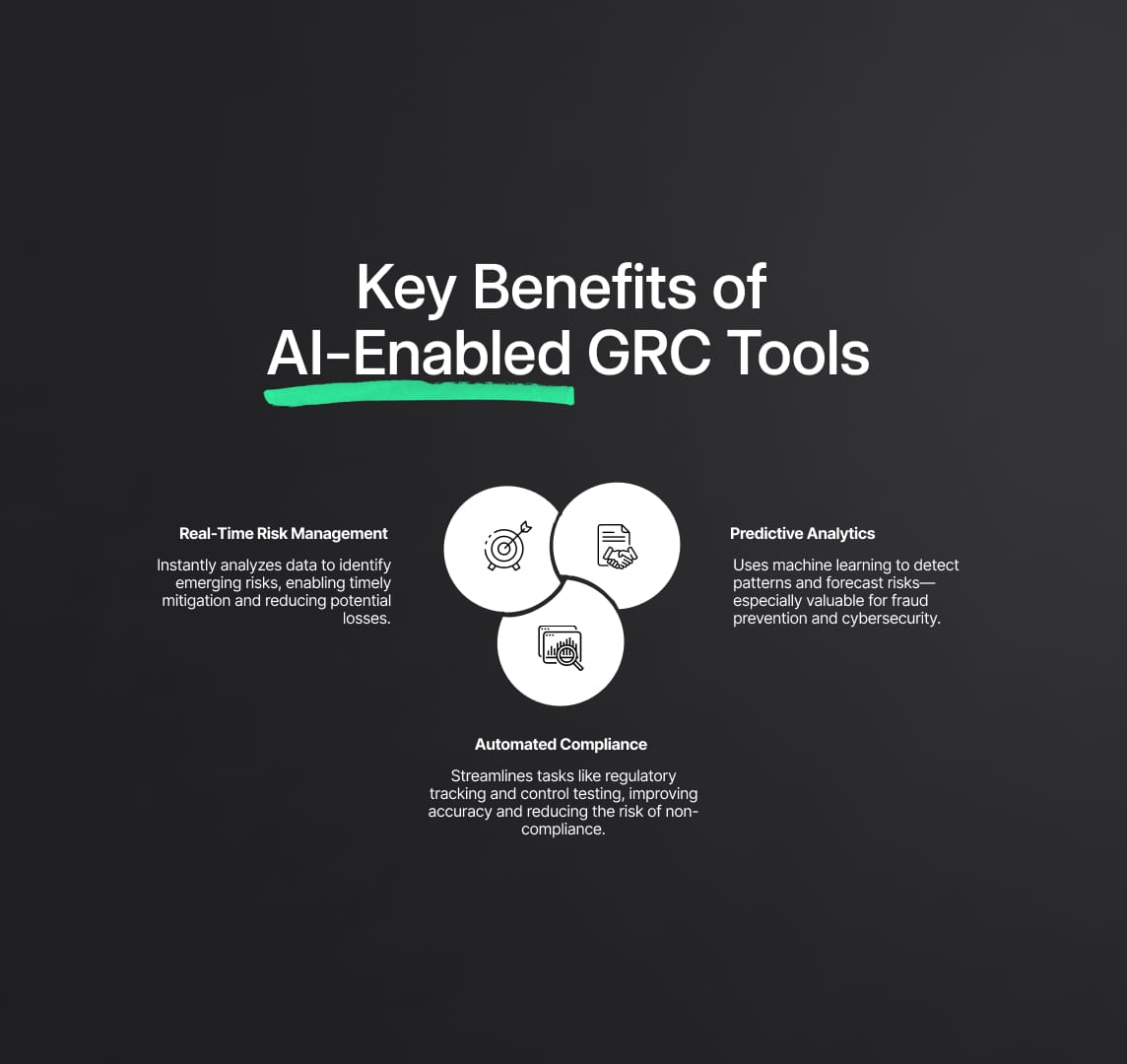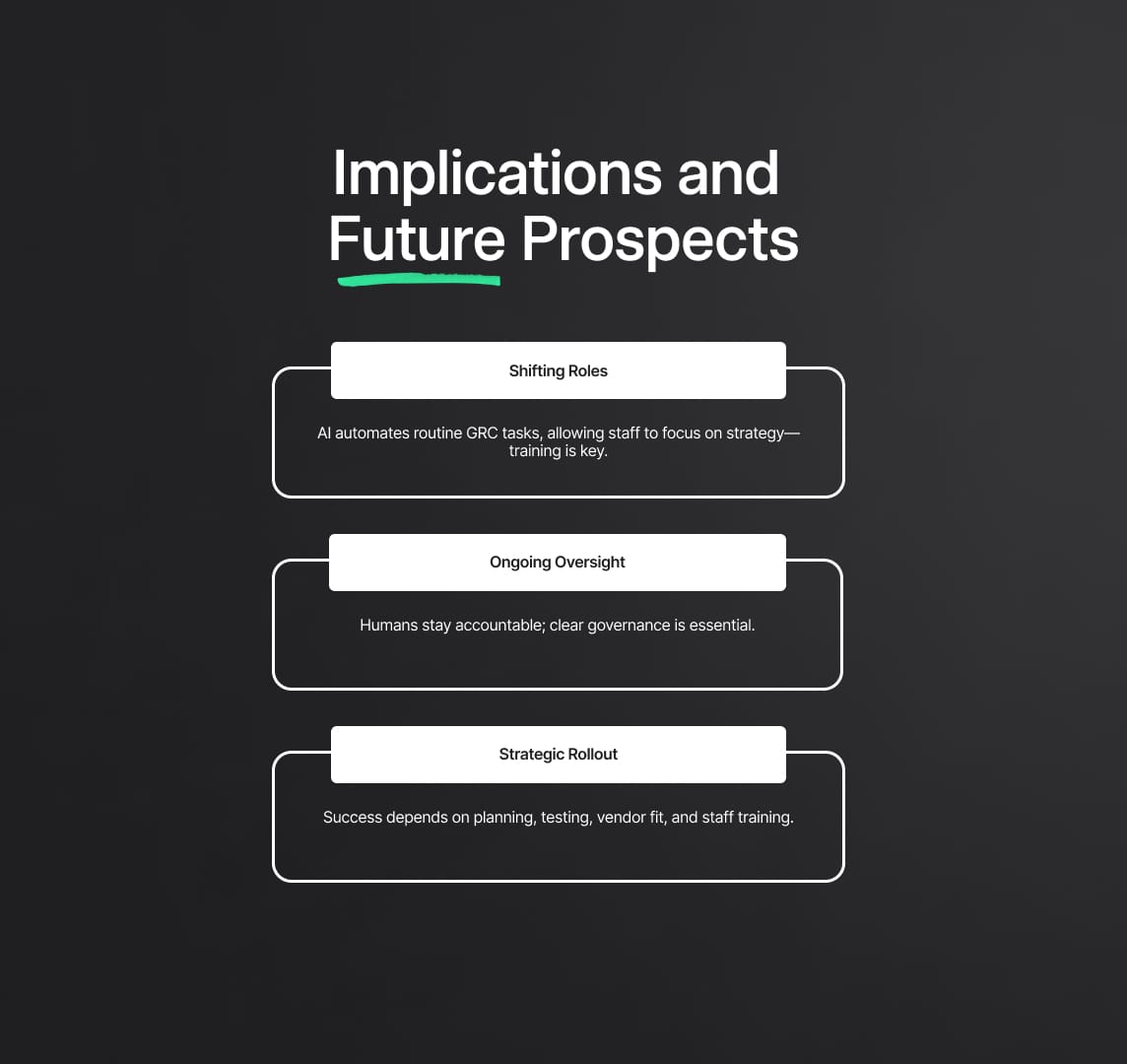How AI will enhance GRC Software solutions?
AI revolutionizes GRC software by automating data collection from diverse sources, enabling continuous monitoring and updates. It converts data into actionable intelligence, providing insights into risks and compliance.

Grand “Answer”:
AI will significantly enhance GRC (Governance, Risk Management, and Compliance) software solutions by automating the data collection process from various sources, such as regulatory bodies' websites, social platforms, and both external and internal sources [1]. This automated data collection allows GRC systems to continuously monitor and update relevant information, reducing manual efforts and increasing efficiency [1]. Furthermore, AI-powered GRC solutions can convert the collected data into actionable intelligence through advanced analytics and predictive algorithms, providing valuable insights into potential risks and compliance issues [1][2]. By leveraging AI capabilities, GRC software solutions can significantly reduce the margin of error and enable organizations to make more informed decisions while maintaining regulatory compliance [1]. Overall, the integration of AI within GRC systems will lead to more accurate, efficient, and effective risk management and compliance strategies [1][2].
Source
[1]


GRC Software: AI Revolution
In the dynamic landscape of the global business environment, effective Governance, Risk, and Compliance (GRC) strategies are fundamental. Traditional GRC methods, once considered effective, are struggling to keep pace with the modern labyrinth of regulatory requirements and the multifaceted dynamics of business environments. Amidst this backdrop, a transformative innovation has emerged: Artificial Intelligence (AI)-enabled GRC tools. Powered by sophisticated machine learning algorithms and natural language processing capabilities, these tools are poised to revolutionize the way risk is managed, compliance ensured, and governance is improved.
Industries that are subject to rigorous regulations, like the financial and health sectors, stand to gain enormously from AI-enabled GRC tools. Implementing these cutting-edge tools can bolster risk management procedures, optimize compliance processes, and dramatically reduce the risk of non-compliance penalties. However, the deployment of these AI-enabled GRC tools is no small task. It requires careful planning, robust collaboration across multiple organizational departments, and a carefully strategized execution plan.
Successful implementation demands a structured approach. This begins with identifying specific business requirements, selecting an appropriate vendor, customizing the tool to cater to specific needs, integrating the tool with existing systems, meticulous testing, and comprehensive end-user training. The Agile methodology offers an effective framework for managing this process, ensuring alignment between the solution and the organization's needs, while promoting adaptability and continuous improvement.
Nevertheless, implementing AI-enabled GRC tools isn't without its share of challenges. Some of these challenges include ensuring data privacy, mitigating potential bias in AI algorithms, and the need for continuous system monitoring and fine-tuning. Even though these challenges exist, the potential benefits of AI-enabled GRC tools make them a worthy investment, especially in industries facing intense regulatory scrutiny.
Pros of AI-enabled GRC Applications
- Enhanced Risk Assessment: One of the most significant advantages of AI is its ability to analyze large volumes of data at unprecedented speeds. This capability allows AI-enabled GRC tools to provide more accurate and comprehensive risk assessments. The tools can identify patterns and trends, many of which might be overlooked in manual analyses, enabling organizations to proactively manage risks and prevent crises before they materialize.
- Superior Fraud Detection: Advanced pattern recognition algorithms empower AI tools to detect potential fraudulent activities, thereby mitigating risk. These tools can identify anomalies in transactions, enabling organizations to flag suspicious activities swiftly, facilitating prompt investigations, and minimizing financial loss.
- Effective Regulatory Compliance: AI-enabled GRC tools can actively monitor regulatory changes, keeping organizations abreast with evolving rules and regulations. These tools can automate data analysis and report generation, thus streamlining compliance procedures and reducing the chance of human error.
- Streamlined Operations: By automating routine tasks and eliminating manual processes, AI tools can improve operational efficiency. This increased efficiency not only helps save time but also allows the workforce to focus on more strategic, higher-value tasks.
- Improved Customer Experience: AI can analyze customer data and gain insights into customer preferences and behaviors, providing a more personalized customer experience. It can identify potential issues before they become problems, leading to improved customer satisfaction and loyalty.
Cons of AI-enabled GRC Applications
- Significant Initial Costs: The deployment of AI-enabled GRC applications can be costly. Investments in advanced technology, infrastructure, and talent acquisition can add up. However, these initial costs are expected to be offset in the long term by the efficiencies brought about by these systems.
- Ethical and Legal Considerations: AI brings with it a range of ethical and legal concerns, including potential bias in AI decision-making, privacy implications, and the need for data protection. It is crucial for organizations to navigate these concerns responsibly, ensuring ethical usage of AI and strict adherence to all relevant laws and regulations.
- Diminished Human Oversight: A potential risk of over-reliance on AI systems is the diminished role of human oversight. This reduction can lead to a lack of accountability, and in certain critical situations, could result in flawed decision-making if the AI system encounters scenarios it has not been adequately trained for.
- Technical Challenges: The implementation of AI in GRC applications may also face technical hurdles, including data integrity issues, software compatibility, and the need for continuous system upgrades. Additionally, AI systems require substantial computing power and storage capabilities, which can lead to increased operational costs.
- Skills Gap: AI technology requires a specialized set of skills for its implementation, operation, and maintenance. The existing workforce may need to be upskilled, or new talent may need to be brought in, both of which can incur significant time and monetary costs.

AI-enabled GRC Tools & Software: Detailed view
AI-enabled GRC tools have a wide range of applications that can significantly enhance risk management and compliance practices. Let's explore some key areas where these tools prove valuable:
Real-time Risk Management: AI-enabled GRC tools can analyze vast amounts of data in real-time, providing organizations with immediate risk assessments. By identifying potential risks as they arise, organizations can take proactive measures to mitigate them, reducing the likelihood of financial losses or reputational damage.
Automated Compliance Management: These tools automate various compliance management processes, including regulatory change management, policy management, and control testing. By streamlining these tasks, organizations can ensure consistency and accuracy while saving time and resources. Automated compliance monitoring also helps organizations stay up-to-date with evolving regulations, reducing the risk of non-compliance and associated penalties.
Predictive Analytics: AI-enabled GRC tools leverage machine learning algorithms to identify patterns, detect anomalies, and predict potential risks. By analyzing historical data and identifying trends, these tools can provide organizations with insights to anticipate risks before they occur. This predictive approach is especially valuable in areas such as fraud detection and cybersecurity, where early identification can prevent significant harm.

Implications and Future Prospects
The adoption of AI-enabled GRC tools brings about several implications and future prospects for organizations:
Changing Roles within Organizations: The implementation of AI-enabled GRC tools can lead to a transformation in the roles and responsibilities of risk management and compliance professionals. By automating routine tasks, these professionals can shift their focus to more strategic initiatives and decision-making. However, it is essential to provide appropriate training to ensure these professionals can effectively utilize and understand the outputs of AI-enabled tools.
Increased Accountability: While AI can automate many processes, organizations must remember that humans remain ultimately accountable for decision-making and compliance. Establishing clear guidelines and accountability structures is crucial to ensure responsible and ethical use of AI-enabled GRC tools.
Continuous Evolution: AI technology continues to evolve rapidly, and AI-enabled GRC tools are no exception. As these tools gather more data and refine their algorithms, they will become increasingly accurate and efficient. Organizations must remain up-to-date with these advancements, regularly update their systems, and adapt their procedures to leverage the full potential of AI-enabled GRC tools.
Implementation Strategy and Challenges
Implementing AI-enabled GRC tools requires a comprehensive strategy to maximize their effectiveness. Here are key considerations for successful implementation:
Business Assessment: Conduct a thorough assessment of the organization's current GRC procedures, identifying gaps and determining areas where AI-enabled tools can provide the most significant value. This assessment helps align the implementation strategy with the organization's specific needs and objectives.
Vendor Selection: Choose a reputable vendor that offers AI-enabled GRC tools aligned with the organization's requirements. Evaluate different vendors, considering factors such as functionality, cost, customer support, and ease of integration with existing systems.
Implementation and Integration: Once a vendor is selected, carefully plan and execute the implementation of the AI-enabled GRC tools. This process involves technical considerations, including integrating the tool with existing systems, migrating data, and configuring the tool to align with the organization's unique requirements.
Testing and Validation: Thoroughly test the implemented system to ensure it functions as intended. This testing phase helps identify any technical issues that need to be addressed before full deployment. Validate the outputs and accuracy of the AI-enabled tool through rigorous testing processes.
Training and Education: Provide comprehensive training to end users on how to effectively use the AI-enabled GRC tools. The training should not only cover the technical aspects of using the tool but also help users understand the insights provided and how to apply them in decision-making processes.
While implementing AI-enabled GRC tools may present challenges, the benefits they offer in terms of improved risk management, streamlined compliance, and operational efficiency make them a valuable investment for organizations. By addressing the implementation challenges and following a well-defined strategy, organizations can harness the power of AI-enabled GRC tools to enhance their risk management practices and ensure compliance in an ever-changing regulatory landscape.
Grand Answer: Your AI Partner
Designed to support compliance officers, legal counsels, and other professionals responsible for adhering to regulatory standards, Grand Answer aims to facilitate an efficient and straightforward compliance process.
Reduce your
compliance risks


